Beginning of the Ice – Mount Whitney
Having completed the “easy” +130-mile part of the Winter Badwater, the cooler (than a Fire crossing) desert portion, Heather drove us back down to Lone Pine and the awaiting showers and beds at the Dow Villa. After a short and restless night, Dr. Bob and I hauled our gear into the rooms and laid it all out on the beds and alongside the walls. I am always amazed at the amount of equipment it takes to summit a snow laden mountain. Although I’ve done a good bit of mountaineering, I still worry about having everything I need and question whether or not I remember how to tie figure-eight and prusik knots. As I’ve gotten older, remembering some of these skills has become more of a challenge. Then, I think of Mace and realize I need to be grateful that, at least for now, I can still tie these knots, while he can no longer tie his shoes. I’m also incredibly angry that he has Alzheimer’s. So angry I . . . have to shake my head to chase the thoughts away and refocus on the task at hand.
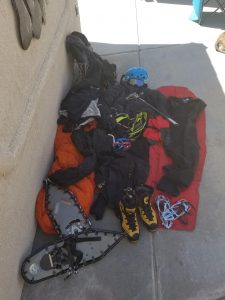
It takes a lot of gear and clothing to climb Mount Whitney in the Winter.
As I insisted and they require, Trevor Athnes, our guide from Sierra Mountain International (SMI), stopped by in the afternoon to go over equipment. When he arrived, we greeted him and shared the usual pleasantries, but he wasted no time, starting with my gear. Helmet and hats; goggles and sunglasses; down, fleece, and gortex jackets; long underwear, warm jumpsuit, and wind pants; gloves and glove liners; sleeping bag and pad; boots, crampons, and snowshoes; harness with locking carbineers; ice axe; and backpack. Check, check, and check. My sleeping bag is rated to 30 below zero, as I learned early on in mountaineering that you don’t scrimp on your sleeping bag, or a good sleeping mat. We moved on to Bob’s room and gear, with another thumbs up. Trevor gave us each an avalanche beacon even though (thankfully!) conditions are such that the risk is low, and our share of food. Finally, we split one of the heaviest things, the two-man tent Bob and I will share, which is an absolute necessity to stay comfortable during the night.
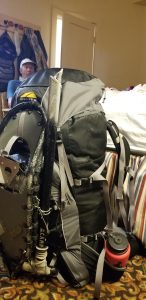
My backpack ready for Whitney, weighing at least 45 pounds.
After he left, Heather commented that he looked the part: probably in his mid-forties, maybe 5’ 10” tall, slender and sinewy, quick to smile, with his hair pulled back in a ponytail. She also had to laugh, commenting that our questions – “Are you going to take your heavy down coat, or a lighter one and a fleece? Are these wind pants okay?” – reminded her of having a friend helping her cook in her kitchen: if she were by herself, she’d know exactly what to do. But, with another person she’s apt to ask things like: “Should I use this pan, or this one instead? How long to do you keep the turkey in oven, at what temps?” When I’ve led expeditions, I’ve been the “expert.” But now I was deferring to Trevor. “That’s not a bad thing,” she said. “We can all use another set of eyes, just like with writing; we all need an editor.” I agree! Nothing wrong with having confirmation that your equipment is okay especially since, in this case, our lives could depend on it.
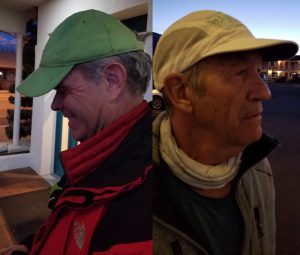
Dr. Bob and Marshall have different faces as they prepare for Mount Whitney.
We agreed to a 6 AM meet up at the hotel. From there, SMI owner Kurt Wedberg would drive us up to the Portal closure point where I had stopped, drop me off, and I would start walking. With a 4WD and in daylight, they felt comfortable driving up the mountain to the point where snow finally blocked their path. That turned out to be a couple of miles, near the campground at approximately 8,000 feet. I met them there, changed into my 6,000-meter mountaineering boots, and Trevor, Bob, and I started off on foot, walking a mile on the snow-covered road to the Portal trailhead. Both Bob and I are used to carrying our own weight, but we were still a bit surprised to guess our packs weighed at least 45 pounds. We were also impressed that Trevor’s pack was probably at least 60 pounds! Is youth wasted on the young, I wondered? I was 40 the first time I won Badwater, and 45 the fourth, and last, time I won. Did I appreciate it fully then? Maybe. But I can say that I was glad Trevor had the youth and strength to haul all the kitchen gear and everything else we needed.
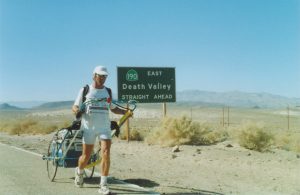
For the first ever self-contained solo BW, I had almost everything, except Vaseline to stop a severe nosebleed.
I often say, “If you don’t have it, you don’t need it.” Hopefully. As we started on the Whitney Trail at the Portals my mind wandered back to my self-contained solo trek across Death Valley to the summit in 1999. One of the things I forgot was Vaseline to coat the inside of my nose to keep it moisturized. Consequently, as I approached 119 miles and crossed the Owens River, my nose started bleeding. Soon both nostrils were gushing, which made it difficult not only to eat, but to breathe. It continued to bleed for over 22 miles, up the Portal road, and past Mirror Lake on the Whitney trail.
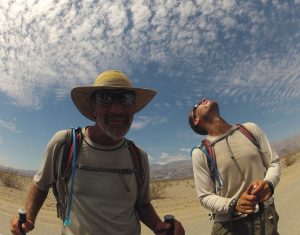
I thought Dave and I had buried everything we needed . . . except soap and first aid. Photo by BW Ben Jones, who came out to see us during the endeavour.
Now, at the Portal trailhead, we started along the same Whitney Trail I had hiked so many times before in the summer. At the North Fork of Lone Pine Creek, we veered right to start along the mountaineers route that I had taken a couple of times but, again, only in the summer. Here we had to put on snowshoes. As a distraction from breaking through the snow and willows, forcing an exhausting lifting and detangling before being able to step forward again, my mind took me back to the 425-mile self-supported circumnavigation of Death Valley National Park I did with my friend Dave Heckman in 2014. We had buried caches of everything we needed at approximately every 13 miles around the border of the park. Huh . . . except . . . we forgot soap and first aid! The first made for an interesting odor throughout the trek, while the second would have come in handy for blister care. There are many other instances that I can recall of things not packed, but we always made do with what we had.
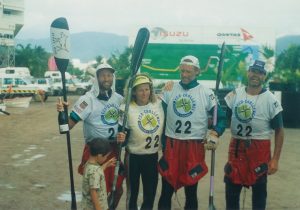
Me, Chaz, Mace, and Dr. Bob at the Eco Australia 1997 finish, where we faced numerous challenges.
The mountaineers route heads pretty much straight up to the top of Mt. Whitney, gaining 6,100 feet in just five miles. Bob paused from his position in the back, looked up the trail, and declared that he would be going back down. He was having a hard time keeping up and felt like he was slowing us down. I implored him to take it one step at a time and stay with us. We promised to slow down, as I felt we were going too fast anyway. I thought about how many things we had been through together, along with Mace, including meeting at the Utah Eco-Challenge, creating Team Stray Dogs; “fending off” grizzly bears during Eco British Columbia to keep Lisa safe; literally riding out the storm in the Coral Sea during Eco Australia; and watching Dr. Bob change into what Heather dubbed “Zombie Bob” due to illness during Eco Fiji, while still moving forward without one word of complaint. Friendships forged through extreme challenges, that have lasted a quarter century, cannot be broken. I was also grateful to have him with us because of his skills and experience – we have hiked up Whitney together several times, he had climbed the Mexican Volcanoes with me; he has also climbed Rainier a few times and has climbed on Denali – along with his always good humor. For all these reasons, it was important to me to have him at least go up to the Lower Boy Scout Lake where we would camp for the night. In true Dr. Bob fashion, he agreed to carry on.
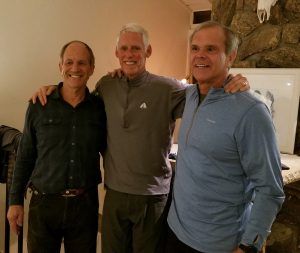
Me, Mace, and Dr. Bob at Mace’s 65th bday party, shortly after he shared his early-onset Alzheimer’s diagnosis with us, his Stray Dogs teammates and friends.
So, the three of us continued to plunge through the snow and crash through the willows. The snow got deeper, and the trail got steeper and more obscure. If Mace would have been with us, he would be swearing right along with, well, at least me, as Bob hardly ever utters a swear word. But when he does, you know he REALLY means it! God how I missed Mace and his ways. While we were always grateful for our good luck to be able to travel and do the sports we loved, the best part was being together: that meant much more than I can say. Looking back, I realize that I was beyond lucky to have met such extraordinary people. Both Dr. Bob and Mace have set a good example and been mentors to me over the decades I have known them. As I detangled my snowshoe from what seemed to be a most persistent willow, I realized that these friendships make the effort of slogging up this hill all worth it.
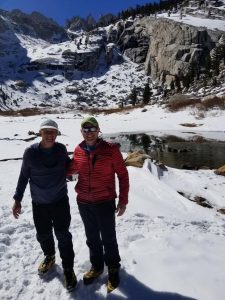
I was so grateful to have Dr. Bob with me at Lower Boy Scout Lake on Mount Whitney.
After a few hours we could see a ledge. We had made it to Lower Boy Scout Lake! We had only covered 2.5 miles but had climbed 2,350 feet to 10,350 feet in just over 5 hours, arriving at 12:25 PM. (I had covered another couple of miles and another 1,000 feet or so, but on the road, in running shoes, with no pack). We discussed options: stay here or continue two more hours to climb to Upper Boy Scout Lake. Bob and I looked at each other and I think we both realized that the day had already been more than we expected. Trevor had downplayed the difficulty we would face on Day 1 for good reason: he didn’t want to psyche us out. He did (easily!) convince us to take the recommended four days, rather than the three I had “planned” to spend on the mountain. So, we would take our time, try to get a good night’s sleep, and have a short Day 2 tomorrow to either Upper Boy Scout Lake or just beyond. Stay at the selected camp that night, attempt the summit push on Day 3 with return to that camp, then Day 4 to descend.
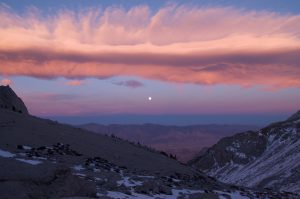
The photo doesn’t do justice to the amazing beauty of the sunset and moonrise, looking east, from Lower Boy Scout Lake.
It was great to be up high on the mountain, where I feel more alive than any other place on earth. As the sun set around 4:00 PM behind Mount Whitney, it instantly became cold and begged us to dive into our tents. We were the only ones on the mountain that night, making the quiet something to behold. The silence was broken by Trevor beseeching us, “Guys, you have to come see this.” I crawled out of our tent, joining Trevor, while Bob stuck his head out for a look. Even though the sun had set, the reflection cast on the clouds and valley to the east were like from a rainbow. The clouds burned brightly pink and orange. Red and green hues embraced the foothills, while the full moon hung over the valley pointing down to Lone Pine where we had started this morning. I fantasized was just for me and could hear the mountain gods whispering to me that all was well. Always, I look for strength to be derived by paying attention to what nature provides, which is a fantastic source of motivation. This was one of the most spectacular displays of beauty I had ever seen, set in juxtaposition with power, shear power, that would propel us upward to the top.
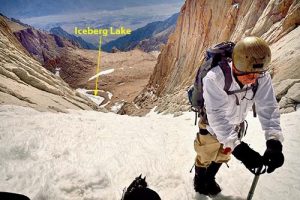
Photo from SMI showing a climber going up the steep mountaineers chute, with Iceberg Lake below.
Through the night the stars shone for us and rotated over the valley and mountain tops as if to say, “You are at home to roam as you please.” It was such a peaceful and simple existence. As the moon rose overhead, its light shown brightly through the thin yellow walls of our tent. Bob seemed to sleep reasonably well despite my shuffling about every five or six hours to re-inflate my sleeping pad, which had developed a slow leak allowing the cold to radiate up from the ground when it go too flat. It really didn’t matter as I was mostly awake anyway, fretting about what the challenges we would face in upcoming days. Looming large were thoughts of the last less-than-a-mile up the mountaineers chute with angles between 25-45 degrees, gaining almost 1,500 feet from Iceberg Lake at 12,620 feet to the top of the Notch at 14,100. That’s some serious climbing in snow and ice. Would I be up to the task?

Dr. Bob and I climb the steep trail from Lower to Upper Boy Scout Lake.
The sun began warming our tent around 10 AM, signaling us to get moving. We broke camp, packed up our gear, and started heading up the steep route in our snowshoes, laden with still-heavy packs. While it was difficult, I love the challenge of climbing, focusing on my breathing, and settling into a rhythm as we continued ascending through the cold, crisp, clean air. After a mile and about 1,000 feet of elevation gain, we reached Upper Boy Scout Lake at 11,300 feet. It had only taken a couple of hours, just as Trevor had predicted, and we discussed whether we should continue to an optional second camp between here and Iceberg Lake. Doing so would make summit day shorter, but a water source would be further away. Dr. Bob was feeling “a little beat up” and exhausted from the steep climb, and I wasn’t opposed to nice afternoon of rest, so we decided to call it a short day.
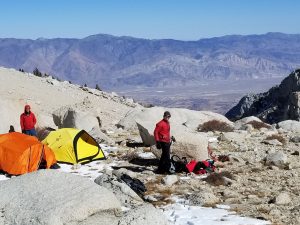
Trevor and Dr. Bob at Upper Boy Scout Lake, our home for the next two nights as we prepare for, and hopefully recover from, the summit push on Mount Whitney.
This would be our base camp for the next two nights, before and after what I hoped would be a successful summit of Mount Whitney and the first ever Winter Badwater to raise money for the Alzheimer’s Association in honor of Mace. He’d love it here, I thought. I wish he could have joined us, completing the Stray Dogs original male trio. But, in a way, he was there, as Bob and I talked about him all tThe time, sharing stories of misadventures we’d shared. Trevor had to feel like he almost knew Mace himself.
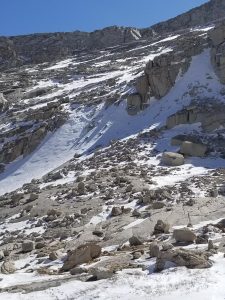
As I looked at part of the route to the summit from Upper Boy Scout Lake, I wondered if my spirit would carry me to the top.
As I looked up at the part of the route we could see, my mind wandered as I recognized how these challenges are creative outlets for me. No one had ever tried a Winter Badwater before, so here I was, giving it a go. Just as no one had ever attempted a solo-self-contained crossing, a Badwater Quad, or a self-supported circumnavigation of Death Valley National Park before I created these, and other, challenges. I always marvel at how amazing the human spirit is and thought, as they say, “If something like this was easy, everyone would be doing it.” I would find out tomorrow how durable my spirit just might be.
Coming soon . . . Fire and Ice Part 4 – The Crux of the Crossing






















